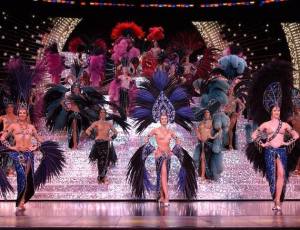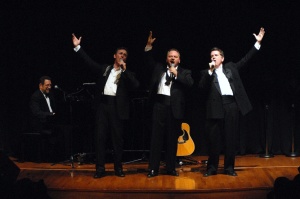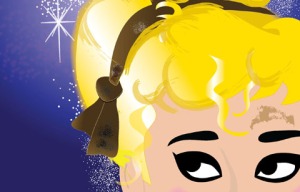Now that Bally’s Jubilee! has been officially shuttered for the next month to update and change unspecified portions of the show, questions still abound about what prompted this decision of Caesars Entertainment to give up on the last gem of the golden age of Las Vegas showgirl production shows.
In a cynical sense, change in Las Vegas entertainment is always driven by one thing: money. Shows were originally mounted in casinos to attract, retain and reward gamblers. It’s only logical that if Caesars felt changes must be made to Jubilee! it was because the show was not generating enough money. Since the show was paid off decades ago, and the performers are paid the least of any performers on the Strip, the lack of profit must primarily be due to lack of ticket sales.

Jubilee! is as beautiful and gorgeous as at any time in its 33-year history; wardrobe legends Donna Shad London and Marius Ignadiou have done extraordinary work in preserving the condition of these decades-old costumes. The gorgeousness and retro-quality of the show would be any Las Vegas marketer’s dream because of its uniqueness, high production quality, and historical value. The show should be raking in the money.
So, if the show is aesthetically spectacular, with a world-class talented cast, and is the last jewel of an era that millions pine for, why is it not selling?
In marketing terms, it’s not selling because the target audience is not being reached or influenced. In public relations terms, it’s not selling because it hasn’t been branded effectively.
Looked at with a non-insider’s eye, marketing and PR efforts lack some important components:
- There are no social media channels for Jubilee!.
- There is no active official Facebook page for Jubilee! There is a Facebook page entitled “Jubilee! at Bally’s Las Vegas”, but it has no posts, and so appears unused. 9,448 people have visited the page (that’s 9,448 people out of 40 million Las Vegas visitors each year), but there is no indication how many likes it has. There is no impetus for anyone to “like” this page, as it appears inactive. So, there is no active Jubilee! page on Facebook for audience members to “like” or follow. Therefore, there are no daily posts showing up on followers’ Facebook pages to remind them of the gorgeous show, which is the whole idea of social media in marketing.
- “The Pulse of Las Vegas”, Caesars’ Facebook page, occasionally posts about Jubilee! special appearances, but does not promote the show or describe it.
- There are no Jubilee! Instagram or Twitter accounts — no other social media that is easily found by Internet surfers. There are no links on the Bally’s website entertainment page to any social media.
Dear Caesar’s PR/marketing team,
Facebook and social media are free advertising.
Sincerely,
Everyone on planet Earth.
- There are no Jubilee! souvenirs or t-shirts on sale. From a marketing view, souvenirs and t-shirts are one of the most popular items for tourists, and one of the most effective ways to spread the word about the show in distant parts of the country and world. A show-goer has no memento of the Jubilee! experience, and therefore, it fades in his memory as soon as another experience creates a more immediate memory. If a show-goer had a t-shirt or desk souvenir that could be worn or displayed in the weeks after the show, the memory of the show would be rekindled, the show-goer would likely tell others about it, and maybe make plans to return again. Word-of-mouth would be created, and the show-goer’s friends might put Jubilee! on their lists of things to do in Las Vegas. Nothing (i.e. no souvenirs) leads to nothing, unfortunately.
- There are no programs. This abolishes any chance of audience members bonding with the cast and show, as programs give information, stories, and up-close images that people relate to and remember. Another lost marketing opportunity.
- There are no billboards of Jubilee! around town, only two on Bally’s own marquee, and even that is reduced from the previous three. If you are driving eastbound on Flamingo, you see no advertisement for Jubilee! on the Bally’s marquee. There were many years when Jubilee! did not even do taxi cab banners.
- There are no local TV commercials for the show that this writer has seen, as a member of a moderate TV-watching public.
- Jubilee! is listed at the bottom of the entertainment show page on Bally’s website, below every other entertainment offering at Bally’s. It is listed AFTER “Tony & Tina’s Wedding”, (which isn’t even running); below once-a-week shows “Dancing Just Like the Stars” and “Rocky Horror Picture Show”; and below a singer who imitates other singers and doesn’t even have a national name in the US. Any PR or marketing person knows that website viewers tend not to scroll to the bottom of pages. So by pushing Jubilee! to the bottom of the page, they are burying it beneath imitators, not-open shows, and once-a-week, low-production knockoffs. This is not the way to promote a multimillion-dollar, world-class show.
- Jubilee! has made some recent guest appearances on TV talk shows, which is great PR placement. Guess how most of us found out they had happened? Social media postings by the cast.
This lack of, refusal to implement, or ignorance of modern and effective promotional techniques leaves people who care about Jubilee! feeling one thing: that Jubilee! has been abandoned by Caesars.

Caesars has the amazing opportunity — nay, the responsibility — to keep Las Vegas showgirls alive in the mind and awareness of the public, if they want it to sell tickets. Caesars has a virtual lock on the Las Vegas showgirl – they basically own the brand, as no other show has classic Vegas showgirls wearing $3,000 Bob Mackie costumes. How they have not seen this as an opportunity to take over the image and make it work for them is beyond the comprehension of outside PR professionals. It’s a tragically lost opportunity, in marketing, sales, and to lovers of classic Las Vegas entertainment.
Dear Caesars Marketing/PR Team,
Many people love to see gorgeous, gifted, topless dancers draped in glittering rhinestones tell a story through dance. So, please let us know that you still have them on stage.
Sincerely,
Everyone in the world
By bringing in the choreographer of a current hip hop/pop celebrity to revamp the show, it seems apparent that Caesars is targeting the Millennial generation as preferred audience members. Which is fine – although it ignores the fact that many Millennials have never learned to appreciate full-length live theatre or elegant performances; they only know Youtube videos and Pussycat Dolls (although Dancing With the Stars is helping with that, somewhat).
Hiring this new choreographer has garnered some news coverage for the show, but mainly within Las Vegas and regional print newspapers and online news.
The best way to find and communicate with Millennials is through social media. That’s where they live. So, even if Caesars is willing to pay for new choreography and music, their target audience won’t know about it, or learn why they should care, unless Caesars goes to where they hang out. Not print newspapers, not TV news. Online — in social media.
Since 2010, notably, the fastest growing demographic of Facebook users is senior citizens — people aged 50 and older. This older generation, known as the “Baby Boomers”, appreciates and seeks out classy theatrical productions, and would highly value information about shows like Jubilee!
If social media and innovative branding had been used expediently, years ago, to promote the show, would the image and popularity of showgirls have been resurrected and ticket sales enhanced, without even needing to bring in such drastic changes and cost to the show? Has corporate resistance to new media, and lack of creative thinking, lost Caesars millions of dollars in ticket sales, and squandered the potential title of “home of the real showgirl”?

From a marketing and PR standpoint, here are some suggestions for promoting Jubilee!:
- Team Jubilee! up with “Dancing With The Stars”. It would be great PR for Jubilee! and for DWTS. Bring in guest celebrity/pro duos from DWTS to do Pink & Purple Ballroom, Top Hat, or any act, on a monthly basis, and then actually promote them on your new…
- …Social media channels. You should be using all of them. Facebook, Instagram, Pinterest, Twitter, and more. Need some help? Ask any 14-year old.
- Hotel outdoor wrap advertisement with Jubilee!’s name on it. Full coverage of the entire Strip-facing side of the hotel. Using Jubilee! showgirls in the current restaurant wrap is nice, but it looks incidental and does not actually promote the show directly.
- Bring in internationally-known guest artists, who use retro style in their performances, for guest spots. Justin Timberlake, Neil Patrick Harris, Hugh Jackman, Michael Buble, Michael Feinstein, Tommy Tune, Catherine Zeta-Jones, Renee Zellweiger, Richard Gere, Jason Alexander could all be candidates. Brand Jubilee! as THE place for classy, musically-trained pop and movie stars to show their singing and dancing skills. And then, you could mention it on…that’s right! You guessed it correctly…your new social media channels.
- Hand out free Jubilee! postcards to every audience member as they leave. People love free things. They can take photos of it and post it on their Facebook pages. Then their friends will see what show they went to. It’s a handy way to control the online image of show. This is called what, Caesars? Right again! “free advertising”. Did you also know your PR department can track social media mentions, so you can actually measure how your free advertising is working? Cool, huh.
Jubilee! is a timeless icon of lush beauty and elegance that speaks across time and cultures. It is an important cultural institution. Caesars shouldn’t abandon it without updating — updating the marketing and PR efforts. It CAN reach a new audience without changing the essence of the show. Brand it right, promote it smartly, and Caesars will have an irreplaceable money-maker on its hands for a very, very long time.
Disclosure: This writer was a performer in Jubilee!. This writer is near completion of a Masters degree in Media & Communications Psychology from Touro University Worldwide. This writer receives no remuneration for posts to this website.















